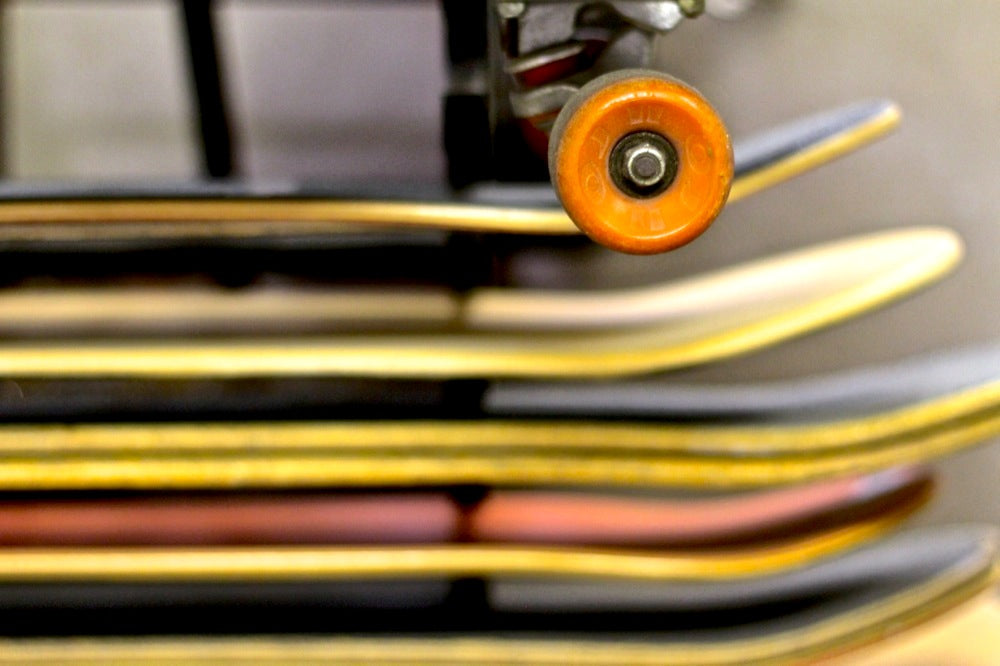On a Sunday afternoon in 2007 in New Haven’s 9th Square, Lou Cox heard the unmistakable sound of spray paint outside his skateboard and hip-hop shop Channel 1, where a group of kids was vandalizing the store’s alley-side wall. He caught one of them, and when the men-in-blue arrived, an officer recognized the boy. Learning about his chronic mischief and absent father, Cox, a recent father himself, felt a sense of responsibility towards the boy.
Instead of pressing charges, he told the boy to bring his friends to Channel 1 the next day where he’d help them hone their craft—after they cleaned the paint off his wall. The kids showed up and made good on their end of the deal. So did Cox. He gave them pads and pencils and brought in his graffiti friends—many of whom the boys admired—to teach them some of the basics, like how to make clean lines and artful letters.
But he didn’t stop there. Cox went looking for a wall where the boys could put it all to use without harming anyone or putting themselves at risk. Through Cox’s efforts, the project snowballed and drew support from neighboring businesses, the Office of Cultural Affairs, the mayor and even Cey Adams—renowned New York graffiti artist and graphic designer for Def Jam Recordings—who’d heard about Cox’s efforts.
sponsored by
There was music all day, the boys got to paint legally and it turned into the first of Channel 1’s many block parties. Cox and his partner and wife, Leslie Cohen, helped host a total of seven such parties, along with multiple breakdance jams and a constant stream of gallery shows by local and New York-based artists—a new name every six to eight weeks, he estimates.
But the vibe of the 9th Square was changing, and for his business, opened in 2005, downtown “had became expensive without the return.” So in 2011, Channel 1 moved to Trolley Square—a larger, more industrial space, but also more remote, located on the far side of the State Street Bridge reconstruction project.
People thought Channel 1 had disappeared. Retail sales of an inventory consisting primarily of skateboarding and graffiti supplies suffered, and Cox says he was prohibited by his landlord from installing appropriate signage to help increase awareness. But the new real estate did allow Channel 1 to take on a variety of new services, including designing and producing T-shirts, car wraps and signage for others.
Ironically given his own signage troubles, Cox says he was able to get permission to bring in graffiti artists to decorate the outer walls of the building with high-quality street art. Strange as it may seem, it’s a viable strategy for combating vandalism, relying on an informal code of honor that keeps lesser artists from painting over the work of better ones. From I-91, you can see the “wildstyle” of Hi Crew and a mural by the anonymous street artist Believe in People.
Cox’s relationship with BiP began years earlier when Channel 1 was still downtown. One day, a regular customer came into the store not to buy his usual spray cans but to give Cox a letter. Signed by BiP, it marked the beginning of a silent correspondence between Cox and the clandestine artist.
More letters followed and over time Cox earned BiP’s trust. Enough so that, in 2013, BiP contacted Cox about painting a mural on Channel 1’s wall. Everything was arranged through email or middle-men and, one morning, Cox found a businessman dangling from the fingers of a baby painted on his wall. The artist had come and gone without Cox ever laying eyes on him.
Then, in early 2014, with BiP planning to leave New Haven on an indefinite sojourn, the artist chose Channel 1 to screen a farewell documentary, BiP: The Mixtape. In the 45-minute film, which only screened once, and in which the artist appeared silhouetted with his voice masked, BiP thanked the people of New Haven for their support over the years. He also hinted at his past as an Ivy League graduate, a disillusioning start to a career in finance and a renunciation of commercialism in art. When the video ended, no one—including Cox—was much closer to determining his identity.
Later that year, Trolley Square was sold to a new owner, whose plans for the building were vague and ominous enough to unsettle some of the building’s current tenants, Cox among them. So this past New Year’s Eve, without much fanfare, Channel 1 moved to its new location at 321B Forbes Avenue, across the harbor. It’s now a leaner operation, no longer selling skateboards or hip-hop apparel (though some boards remain as decorations and mementos), but it continues to take on graphic design work and collaborative public art projects in New Haven. Partnering with Site Projects, Cox played a major role in orchestrating the painting of the now glorious skate park next to Coogan Pavilion in Edgewood Park, and is helping with forthcoming mural projects in coordination with Music Haven and Squash Haven.
Some of those familiar with the old Channel 1 are perplexed that it no longer has a storefront, Cox says. But his new vision for the business is as a creative maker-space—not a place flush with 3D printers or high-end gadgetry, but rather a down-to-earth workshop for local artists like sculptor Silas Finch, who’s been coming to the shop to weld, or painter Zeph Farmby, who comes to work on canvases too large for his home. He also plans to revive Channel 1’s legacy as an offbeat gallery space, to help artists who aren’t getting the attention Cox thinks they deserve.
In short, Channel 1 is changing, and not for the first time. But at least one thing remains the same: whether you’re a kid tagging on the wrong side of the law, or a cloak-and-dagger provocateur whose weapon is paint, or an emerging artist in need of a showcase, or a more established artist looking for some extra workspace, you’re an artist in New Haven, and that means you’ve got a friend in Channel 1.
Channel 1
321 Forbes Ave, Unit B, New Haven (map)
Visitors by appointment
(888) 746-7241 | info@channel1online.com
Written and photographed by Daniel Shkolnik.









